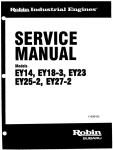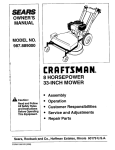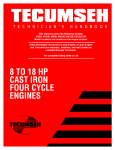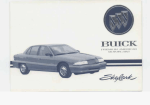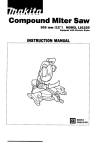Download 4250, 4505, 8605 AND LATER COMPLIANT MOWERS
Transcript
4250, 4505, 8605 AND LATER COMPLIANT MOWERS SCAMP MODELS SELF-PROPELLED SERVICING AND ADJUSTMENTS All LawnBoy Compliant Scamp ModelMowers feature a Flywheel Brake system. It will stop the bladefromturningwithin 3 secondsafterthe operator releases the bail. The engine also stops at the same time. Adjustmentsand servicing of the Scamp selfpropelledmowers are very differentfromall previous models of self-propelled mowers. SAFETYWARNING: Before anyadjustmentsor repairs are attempted, disconnect and remove spark plug to prevent starting. INSTALLING CONTROL ROD 1. Place retainer clip on clutch arm with long side of clip on the inside of clutch arm. 2. Align hole in clip with hole in arm and assemble lower end of the control rod in hole. 3. Turn (swivel) long end of clip up and snap into position on lower control rod as shown. SAFETYWARNING:The lower selfpropel control rodmust be assembled to clutcharm as shown.If not theselfpropel mechanism will not return to neutral when thecontrol lever is released from the engaged position. SCAMP MODELS SELF PROPELLED SERVICING AND ADJUSTMENTS 4. With the control handle in “neutral” (free) posi- tion as shown. 6. Secure upper and lower control rods together with the clampscrew as shown.This screw should be tightened securely by hand. 5. With the clutch arm resting on the handle and wheel bracket as shown. SAFETY WARNING: Improper tightening of clamp screwon control rod may result in operator loss of drive control mechanism. NOTE: To put mower in motion, pull upward oncontrol handle andhold in drive position. To stop forward motion of mower, release control handle. Mower drive mechanism functions only when the control handle is held in “DRIVE” position. 19.42 1983 SERVICE BULLETIN REFERENCES SCAMP MODELS SELF PROPELLED SERVICING AND ADJUSTMENTS DRIVE ROLLER ADJUSTMENT 1. With the control handle in “Neutral”, place both 2. Loosen bolt and nut located in drive roller gap rear wheel height adjusters in #1 (lowest) cutting adjusting slot on each side of drive roller bracket. position as shown. A gap of 3/16” should appear between the drive rollers and tires. 3. Move the drive roller bracket up or down to obtain thenecessary 3/16’’ drive roller gap. Hold bracket in position and tighten both bolts and nuts securely. SCAMP MODELS SELF-PROPELLED DRIVE BELT REPLACEMENT AND SERVICING V BELT REMOVAL OR REPLACEMENT SAFETY WARNING: To prevent starting engine, disconnect spark plug lead and remove spark plug. The “V” belt used onthe utilityself-propelled model mowers is a SPECIALBELT. DO NOTUSE A SUBSTITUTE. It won’t work as WELL or as LONG. To remove the belt: 1. Remove four belt guard cover screws and remove cover. 2. Turn mower up on side and remove nut, blade and collar. Remove three bolts securing muffler and crankshaft support. Remove muffler. 19-44 1983 SERVICE BULLETIN REFERENCES SCAMP MODELS SELF-PROPELLED DRIVE BELT REPLACEMENT AND SERVICING SAFETY WARNING: To prevent starting of engine, disconnectand remove spark plug prior to removing the engine. 3. Remove three bolts securing engine to muffler plate and remove engine. NOTE: Do not remove muffler plate from housing when removing engine. 4. Remove engine and remove drivebelt from drive pulley. SAFETYWARNING: Do notoperate mower with belt guard removed. 5. Remove roll pin from left hand drive roller and remove roller. 6. Remove belt from driven pulley and slide shaft assembly to the right.Remove belt frommower as shown. SCAMP MODELS SELF-PROPELLED DRIVE BELT REPLACEMENT AND SERVICING NOTE: After thebelthas been removed, examine for broken, cracked or misaligned pulleys. The condition and the wear pattern of the belt will provide cluesfor the above possibilities. Replace damaged or worn pulleys. 7. The crankshaft pulley (drive pulley) is secured to the crankshaftwith a SPECIAL slotted set screw. Theend of this screw locates in ahole in the crankshaft. The correct position and tightness is very IMPORTANT. If nottightened securely, damage to the pulley, crankshaft and premature wear of the drive belt will result. NOTE: Apply OMC Ultra-Lock Part No. 388517 to threads of set screwprior to installation. 8. When reinstalling pulley to crankshaft, the side of the pulley with set screw is the lower side. If assembled upside down (set screw on top) misalignment and interference of pulley operation will result. Alwayscheck pulley for damage. Replace if necessary. 19-46 1983 SERVICE BULLETIN REFERENCES SCAMP MODELS SELF-PROPELLED DRIVE BELT REPLACEMENT AND SERVICING IDLER PULLEYS SAFETY WARNING TOP STRAND 1 DRIVEBOTTOM STRAND ENGINE SHAFT PULLEY SAFETY WARNING: Incorrectdrive belt installation may allow mower to operate in reverse direction causing injury to the operator or bystanders. Assemble drive belt as shown. DRIVE PULLEY INSTALL BELT AS SHOWN FOR PROPER PULLEY ROTATION 11. Check the condition of the drive shaft, bronze bearings, and sleeve. If signs of damage or wear appear, replace them. 1983 SERVICE BULLETIN REFERENCES ................................................................................................................................................................... 19.47 SCAMP MODELS SELF-PROPELLED DRIVE BELT REPLACEMENT AND SERVICING INSTALL BELT AS SHOWN FOR PROPER PULLEY ROTATION 12. Reassemble the drive shaft into the bearing and slide it to the left as far as possible. Assemble the washer and drive roller on the drive shaft. 13. The drive rollers must be properly installed to utilize the self-cleaning feature. Properinstallation is with the vee pointing toward the wheel. 15. As you face the front of the mower, twist the forward end of the belt 1/4 turn counter clockwise and assemble on the enginedrive pulley. Assemble engine on muffler plate andsecure with three bolts. 14. Using a new roll pin, assemble the drive roller to the drive shaft. Use a 5/32” or larger drift punch, drive the rollpin into place, flush with the outer surface. Neither end should protrudebeyond the roller surface. 16. Release spring tension on idler pulleys and assemble belt on drive shaft pulley. Reassemble idler pulley spring and rotate the belt several revolutions. Check to make sure the belt is centeredon the’ pulleysand TURNING IN RIGHT DIRECTION. Note direction of arrow on large pulley in illustration above.Check andadjust belt tension if necessary. Referto BELT TENSION ADJUSTMENT. NOTE When replacing either of the. belt idler assemblies, use idler kit part no. 682374for the top and kitpart no. bottom. 682564 the on 19-48.... 1983 SERVICE BULLETIN REFERENCES 2. Drive beltshould be checked to insure that proper tension exists in order to prevent premature belt failure. Lift floatingidler from theupper strand of “V” belt. Belt will then become loose.Set floating idler onto “V” belt and check clearance between thetwostrands of the “V” belt. The distance between the two strands should not be less than 112” as shown. complished by measuring the distance from the front edge on the height adjuster brackets to the 1/4” diameter gage holes located directlyin front of these brackets as shown.This distance mustbe the same for bothsides. Before tightening screws make sure the distancebetween the strandsof the “V” belt is not less than 112”. Tighten the four handle bracket screws and the two side screws securely.Reassemble beltguardto self-propel previously screws mechanism using removed.’ SAFETY WARNING SAFETYWARNING: Do notoperate mower with belt guard removed. SERVICE BULLETIN REFERENCES 1983 19-49 SCAMP MODELS SELF-PROPELLED DRIVE BELT REPLACEMENT AND SERVICING LUBRICATION 50 HOURS FOUR PLACES 1. DRIVE ROLLER BEARINGS-Disassemble rotating shaftcover from self-propel mechanism by removing four screws. Unscrew plug from end of each drive roller (Point “A”). Fill exposed cavity with LAWN-BOY “A” GREASE,PART NO. 610726 OR EQUIVALENT. Replace plug and tighten until snug. Repeat procedureuntil lubricant appears oncrossshaft at Point “B”. Reassemble rotating shaftcover to self-propel assembly. LOWER IDLER ASSEMBLY BOLT-PULLEY-ARM-NUT PART #682564 LOWER IDLER PULLEY-Permanently lubricated. No lubrication required. FLOATING IDLER PULLEY-Do not immerse the idler pulley in solvent. Use a rag containing solvent, clean the holein the idler pulleyand the shoulder bolt thoroughly. Using a small amount of LAWNBOY “A” GREASE or EQUIVALENT, relubricate the shoulder bolt and remount idler pulley assembly in the same order it was originally. AS REQUIRED 1. CLUTCH LINKAGE-Apply several drops of light machine oil on clutch mechanism at all pivoting points. 19.50 1983 ...........................SERVICE BULLETIN REFERENCES SCAMP BRAKE SERVICING AND REPAIR To service and repair system, flywheel brake the remove the shroud and tank assembly.(5 Phillips screws). Figure,3 Remove flywheel screen. (3 screws). Figure 1 Flywheel Removal/Installation It will be necessary to move the Flywheel Brake Arm away from the flywheel (pull back oncontrol bail) to allow removal orinstallation of the flywheel. Figure 2 Lift spacer from top of shroud base. Figure 4 Remove flywheel nut. To break flywheel looseuse a softhammer and rap sharply down onone of the thick fins while lifting with other hand on opposite side of flywheel. NOTE: Do not breakany fins on flywheel. It will be unbalanced and vibrate. SERVICE BULLETIN REFERENCES 1983 19-51 SCAMP BRAKE SERVICING AND REPAIR Pull bail back against the handle brake. to release the Lift flywheel off. Flywheel Configurations 1983 Flywheels are muchtallerthanprevious models. As Fig. 5 shows, the visual difference is quite apparent. NOTE These newflywheels are not interchangeable with those ofprevious Lawn-Boy models. Figure 6 .FlywheelBrakeSystemComponents 1983 Years Previous 1. Retainer Clip 2. cup Figure 5 3. 4. 5. 6. 7. 8. 9. 10. FlywheelHeightComparison “Pigtail” Spring Circuit Switch Switch Retaining Screw Adjusting Bolt Locknut Brake Arm Brake Arm Bolt Cable Retainer Spring It is important to note that two different materials are used on compliancemowerflywheels. Flywheels for all Flywheel Brake models are made of aluminum, but due to the need for additional rotating weight (inertia), the Blade Brake Clutch (BBC) flywheels are made of zinc. The zinc flywheels are plainly marked as such to prevent Pad Brake Wearconfusion. Be certain you install only thecorrect Flywheel Brake Arm (with bonded brakepad) must type flywheel for the specific mower. be replaced if pad wears below .030” at any spot. SAFETYWARNING:FlywheelBrake (Zone and PRS) and Blade Brake Clutch (BBC) flywheels are not interchangeable. The correct type flywheel (aluminum or zinc) is critical to proper CPSC compliance. .030”Minimum Figure 7 19-52 FlywheelBrakePadWear SERVICE BULLETIN REFERENCES SCAMP BRAKE SERVICING AND REPAIR To replacethebrake arm, itwill be necessary to disconnectthebrakecablefromthe engine. Setflywheel the back STEP #6 Thoroughlycleanthethreads of thebolt and apply Lawn-Boy Screw Lock, part number 384848 to the threads. on the engine. STEP #7 Assemble the brake arm and bolt onto bracket. Tighten to 5-7 ft. Ibs. (63-75 in. Ibs.) STEP #8 Reassemble thecable bracket assembly. retainer spring intothe STEP #9 It isnecessary to check thebrake cable adjustment before reinstalling it in the bracket. Figure 8 STEP #1 With flywheel in placeand the bail controlreleased (out of operating position), compress the “Pigtail” Spring by hand,then remove the Retainer Clip, Cup and Spring. STEP #2 Remove the cable from the housing. Remove the flywheel. Figure 9 STEP #3 Remove circuit switch adjusting bolt and lock nut. (See Fig. 6). STEP #10 To adjust the brakecable, loosen the jam nutand back it off.Place the brake cable adjusting gauge, part number 611703over the end of the cable. Assemble theretainer clip (see Fig. 9) on the cable against the gauge. STEP #4 Remove brake armbolt and brake arm.(See Fig. 6). STEP #5 Re-assemblecircuit switch adjusting bolt and lock nut into thenew brake arm. Turnit into bracket until head is against the bracket. (See Fig. 6). SERVICE BULLETIN REFERENCES Turn adjusting nut up against thegauge to apply approximately 5 Ibs. tension. 1983 19-53 SCAMP BRAKE SERVICING AND REPAIR STEP #2 Place a mark on the plunger end at of gauge. (See Fig. 11). STEP #3 Remove the gauge. Figure 10 STEP #11 Turn jam nut against the adjusting nut and tighten. Do not permit adjusting nut to turn. Figure 12 STEP #4 Pull the bail backagainstthehandleandhold Use 1/2”Open end wrenches. (See Fig. 10). it. STEP #12 Set flywheel back on the crankshaft. STEP #5 Turn adjusting boltin untilmark on plunger is flush with face of switch body. STEP #13 Reassemble the Cable into the BrakeBracket, then reassemble the Spring, Cup and Retainer Clip. STEP #6 Tighten nut. NOTE Be sure adjusting boltdoes not turn. After the brake cable is reassembled, it is necessary to check the circuit switch adjustment. NOTE Recheck thisswitchadjustment to prevent the plunger from going in toofar anddamaging the switch internally. If it does not move in far enough, the engine will not start. SAFETYWARNING:Properadjustment of this switchis necessary to insure that blade motion stops within the required time. NOTE If proper switch adjustment cannot be made, check brake cable adjustment (See Fig. 9) as this will affect correct switch operation. Figure 11 STEP #1 Place the switch adjusting gauge on the plunger. 19.54 1983 SERVICE BULLETIN REFERENCES I SCAMP IGNITION CIRCUIT SWITCH TESTING AND REPLACEMENT Trouble shooting circuit the switch. STEP #1 Disconnect both leads from the STEP #7 ‘-Using a driftpunch and hammer, drive the switch body out of the bracket. Fig.(See 13).This will break C.D. pack. the flange on the switch. STEP #8 Assemble the new switch and lead assembly into the bracket. STEP #2 Connect a continuity meter or light tothese leads. STEP #3 Push the plunger in. The meter shouldread “0”or the light should go out. STEP #9 Install the switch retainer screw. Reconnect the two leads onto the C.D. pack. STEP #4 Release the plunger. The meter should indicate a completed circuit or the light will go on. STEP #10 Adjust the switch plunger travel with the gauge, part number 61 1702.Follow steps1 thru 6 on page 14. If the switch isdefective, it requires replacement. SAFETYWARNING:Properadjustment of this switchis necessary to insure that blade motion stops within the required time. Figure 13 STEP #5 To replacethe switch, itwill be necessary to remove the flywheelfor access to theswitch. This permits the brake arm to swing out of the way. STEP #6 Remove the switch retainer screw. (See Fig. 6). SERVICE BULLETIN REFERENCES 1983 19-55 SCAMP BLADE AND BLADE HOUSING Figure 1 Figure 3 Assemble muffler onto crankshaft. A specialtool.crankshaftsupport gauge, part support number 609968 is required to position the correctly do it doesn’t contact the crankshaft. Slide the gauge onto crankshaft with the thin wall of gauge inside of support. Figure 2 Always assemble the crankshaft support with the flange down towards the blade. Figure 4 Clean threads on muffler bolts thoroughly andapply Ultra-Lbck, part number 388517. Install bolts and tighten to 150-190 inch pounds. 19-56.. 1983 SERVICE BULLETIN REFERENCES SCAMP BLADE AND BLADE HOUSING The Blade and Hardwareshown beloware usedon all Lawn-Boy Scamp models. Before assembling collar on crankshaft, checkto be sure it did not get bent or distorted when being removed. If so, replace it. Do not use, because, it will cause vibration. If the blade nut is to re-used, be clean the threads thoroughly. Also clean threads on crankshaft. Apply OMC Ultra-Lock, part number 388517 on the threads. Torque blade nut to 45-50 foot pounds. NOTE After repairs are completed always test the mower for starting, running and blade stoppage time. The required blade stopping timeis 3 seconds or less. It isrecommendedto make 3 tests for blade stopping time and record each for future reference. Figure 5 Torque blade nut to 45-50 ft. Ibs. NOTE: This Blade and Hardware will fit all previous Lawn-Boy mowers, using only the Blade Driver and Blade Nut (as shownin Fig. 5). Do not use the old bladestiffener orwasher with these new blades. Figure 6 SERVICE BULLETIN REFERENCES 1983 If itdoesn't stopin the required length of time, determine what the problem is and correct it. Zone Start Models Brake Cable Routing (console) Tie Wrap Locations 1. Single Tie 2. Double Tie Retainer Cup Removal Hose and Cable Routing Primer Assembly 19-60 I.Primer Hose Brake Cable 3. Brake Cable Retainer Clamp 4. Switch Cable Clamp SERVICE BULLETIN REFERENCES Wire Routing Diagram Zone (manual) Start Tubing SERVICE BULLETIN REFERENCES 19-61 19-62 SERVICE BULLETIN REFERENCES TROUBLE SHOOTING Engine Won’t Startor Hard Starting SCAMP Ignition Circuit (“Kill”) Switch (Zone) The following conditions are indications of Switch misadjustment or failure. Possible Cause No fuel in tank. Fuel valve off. Insufficient or excessive priming. Spark plug lead disconnected. Spark plug fouled. Low compression in cylinder (80 PSI min.) Incorrect air gap between C.D. pack and flywheel. C.D. pack defective. (Refer to “CD Pack Testing,” Pg. 15) Primer hose disconnected from carburetor or connector. Primer hose restricted. (Refer to “Primer System Draining,” Pg. 63) Air filter restricted. Carburetor needle valveincorrectly adjusted. Throttle valve stuck closed. Carburetor-to crankcasescrews not tight. Carburetor-to crankcasegasket leaking air. Float chamber screws loose. Float chamber gasket leaking air. Restriction in high speed nozzle. High speed nozzle loose. Float valve stuck closed. Restriction in fuel passages (tank, valve, hose, float valve seat). Float level set too low. Reed Valves stuck closed or bent open more than .015”. Air leak between crankcase halves. Intake plug leaking or missing. Main bearing seals leaking. Exhaust system restricted. Zone Start Models Bail not pulled backagainst handle. Incorrect kill switch adjustment (See Pg. 54 Fig. 12) Kill switchinoperative. (See “Ignition Circuit Switch Troubleshooting,” Pg.19-17). Brake dragging on flywheel. SERVICE BULLETIN REFERENCES Engine misfireswhen in self-propelling mode Adjust Switch (See Pg. 54 Fig. 17). Engine stops if bailis not heldextremely tight against handle Adjust Switch (See Pg. 54 Fig. 17). Engine won’tstart (no spark) Adjust or replace switch Primer System Draining If a mower is tipped back on its handle (as shown below), fuel may runfromthe carburetor and settle in the lowest point of the primer line when the machine is set upright. If this occurs, remove the primer hose from the carburetor and drain the fuel. Symptoms includerichrunning and hot starting problems. 19-63





















